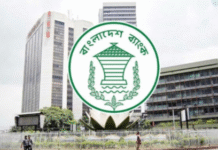BARI scientists successfully test four crops a year; crop rotation to replenish soil fertility
Bangladeshi agronomists have come up with a marvelous way of raising farm output in a land-strapped country.
They have successfully experimented with a “four-crop” model that shows the country’s food production could be more than doubled.
This comes as a great relief for an overpopulated country that loses its scarce farmland to non-farm activities (housing, urbanisation, industrialisation and infrastructure building) by one percent a year.
The agronomists at Bangladesh Agricultural Research Institute (BARI) have found out that if cropping intensity is increased by growing four crops a year in all cultivable lands, farm output will sharply increase.
They have also dispelled concern about over-exploitation of soil resources, saying that the crop rotation would rather replenish soil nutrients with the green manure in sequence left after the harvesting of cereals and other crops.
It is evident from the BARI experiments done in 2011-12 and 2012-13 cropping seasons that by introducing the four-crop rotation, farmers can potentially harvest over 34 tonnes of rice equivalent yields (REY) from each hectare of land. The output is more than twice the farmers usually harvest (14.37 tonnes) in a double-crop-a year pattern.
REY means the amount of rice one can get by selling mustard, potato, rice and whatever grains one grows in a year in a given land.

The BARI field experiments also found that in a double-crop pattern, an average farmer gets a gross return of around Tk 2 lakh by investing just a little over Tk 1 lakh. But the amount of return can be as high as Tk 5 lakh if a farmer goes for four-crop-a year by making an investment of over Tk 2 lakh. The investment is calculated without taking land price/rent into consideration.
At present four crops are grown only in 9,300 hectares of land in the country, three crops in 1.4 million hectares, two crops in 4.1 million hectares and one crop in 2.2 million hectares.
According to official statistics, the country’s total cropped area stood at 14.94 million hectares in recent years as against its net cropped area of only 7.84 million hectares thanks to the 191 percent cropping intensity.
Cropping intensity means the number of crops grown in a piece of land in a year. If one crop is grown in a year, cropping intensity is 100 percent.
 Theoretically, if all cultivable lands come under quadruple cropping, the country’s total cropped area would reach an astounding 31.56 million hectares. Even if all lands come under triple cropping, the total cropped area would be as high as 23.25 million hectares, said officials.
Theoretically, if all cultivable lands come under quadruple cropping, the country’s total cropped area would reach an astounding 31.56 million hectares. Even if all lands come under triple cropping, the total cropped area would be as high as 23.25 million hectares, said officials.
Bangladesh’s cropping intensity has already reached 191 percent, making the country one of the most intensified cropping zone in the world. Now, introduction of the four-crop rotation, as planned by the government, would further increase the country’s cropping intensity (up to 400 percent) and thereby increase the total farm output.
According to a 2009 Planning Commission report, Bangladesh loses over 80 thousand hectares of agricultural land each year, or in other words nearly one percent a year is being turned into non-agricultural land.
It is because of the farmland depletion that Bangladesh slips back, even after achieving rice self-sufficiency in 1999-2000, due to an annual population growth of 2.5 million. Thanks to releases of some high-yielding varieties in recent years and pragmatic policy support, this year the country again reached a self-sufficiency point as far as rice, the staple, is concerned.
Against this backdrop, the BARI is taking the four-crop model to farmers’ plots on a limited scale from the present Aman season on successful completion of a two-year field trials in as many as 14 areas across the country, its Director General Dr Md Rafiqul Islam Mondal told The Daily Star.
He said that over the last two years, they had experimented with various combinations of crops in different areas of the country so that the four-crop model is suited to diverse agro-ecological environments.
“In some regions, we’ll promote ‘Aman-mustard-Boro-Aus’ pattern while in some other regions we’ll suggest the combination of ‘Aman-potato-Boro-Aus’, and in other areas farmers can go for ‘Aman-mustard-mung bean-Aus’. The choices of crops can vary from place to place but the main target remains the same — going for higher cropping intensity,” explained Rafiqul, who heads the largest of all agro-research institutes in the country.
“Cultivable land is decreasing by one percent a year. There are two options to increase farm output from limited land resources — one is increasing the yield of crops and the other is increased cropping intensity,” he said.
The recent development of short-duration Aman and late-sowing Boro varieties, said Rafiqul, has come as a boon since this would further facilitate applying the four-crop pattern by allowing farmers to go for mass scale cultivation of pulses, mustard, potato and seasonal vegetables in between rice crops.
Talking to this correspondent recently, Agriculture Minister Matia Chowdhury said the government would promote the four-crop model since it would help grow more crops from less available farmland in the future.
“Even if we can succeed in helping farmers grow three crops a year in most farmlands (achieving 300 percent cropping intensity), the total farm output will significantly increase,” she hoped.
The minister said since cultivation of irrigated-rice Boro gets taxing for an over-exploited groundwater reserve, “We want to discourage Boro in the uplands and rather want to give the farmers the option of growing two cereals (Aus, Aman), oilseeds and vegetables. In the South, farmers can go for sesame and burley too.”
Apart from increasing farm production, BARI scientists said, crop rotation also mitigates the build-up of pathogens and pests that often occurs when one species is continuously cropped, and can also improve soil structure and fertility by alternating deep-rooted and shallow-rooted plants
Source: UNBConnect










